Communication Challenges in ABC Airline's Catering Department
VerifiedAdded on 2022/11/13
|13
|2684
|58
AI Summary
This report examines the communication challenges faced by ABC Airline's catering department due to intercultural communication. It recommends strategies to enhance communication effectiveness among workers in the catering department.
Contribute Materials
Your contribution can guide someone’s learning journey. Share your
documents today.
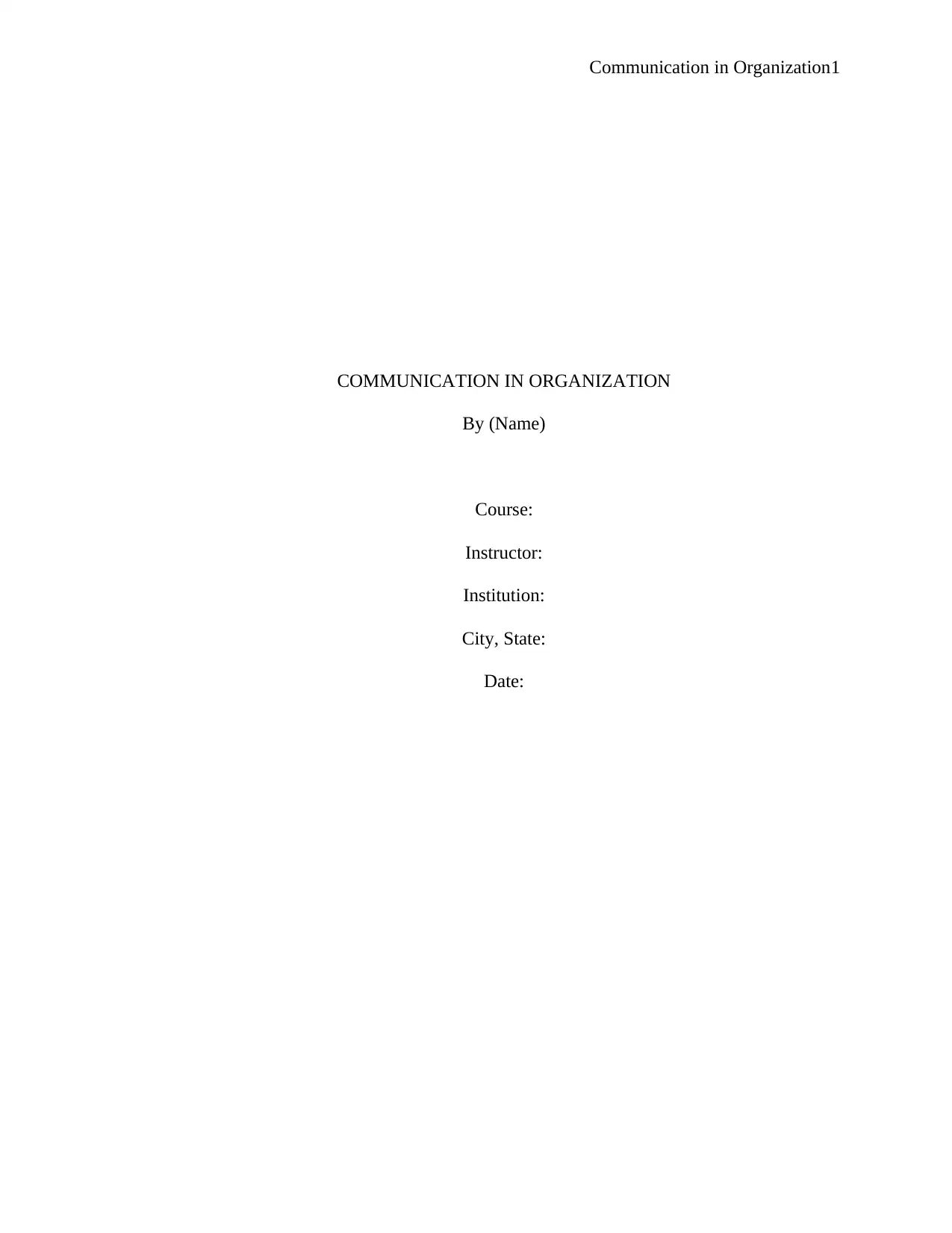
Communication in Organization1
COMMUNICATION IN ORGANIZATION
By (Name)
Course:
Instructor:
Institution:
City, State:
Date:
COMMUNICATION IN ORGANIZATION
By (Name)
Course:
Instructor:
Institution:
City, State:
Date:
Secure Best Marks with AI Grader
Need help grading? Try our AI Grader for instant feedback on your assignments.
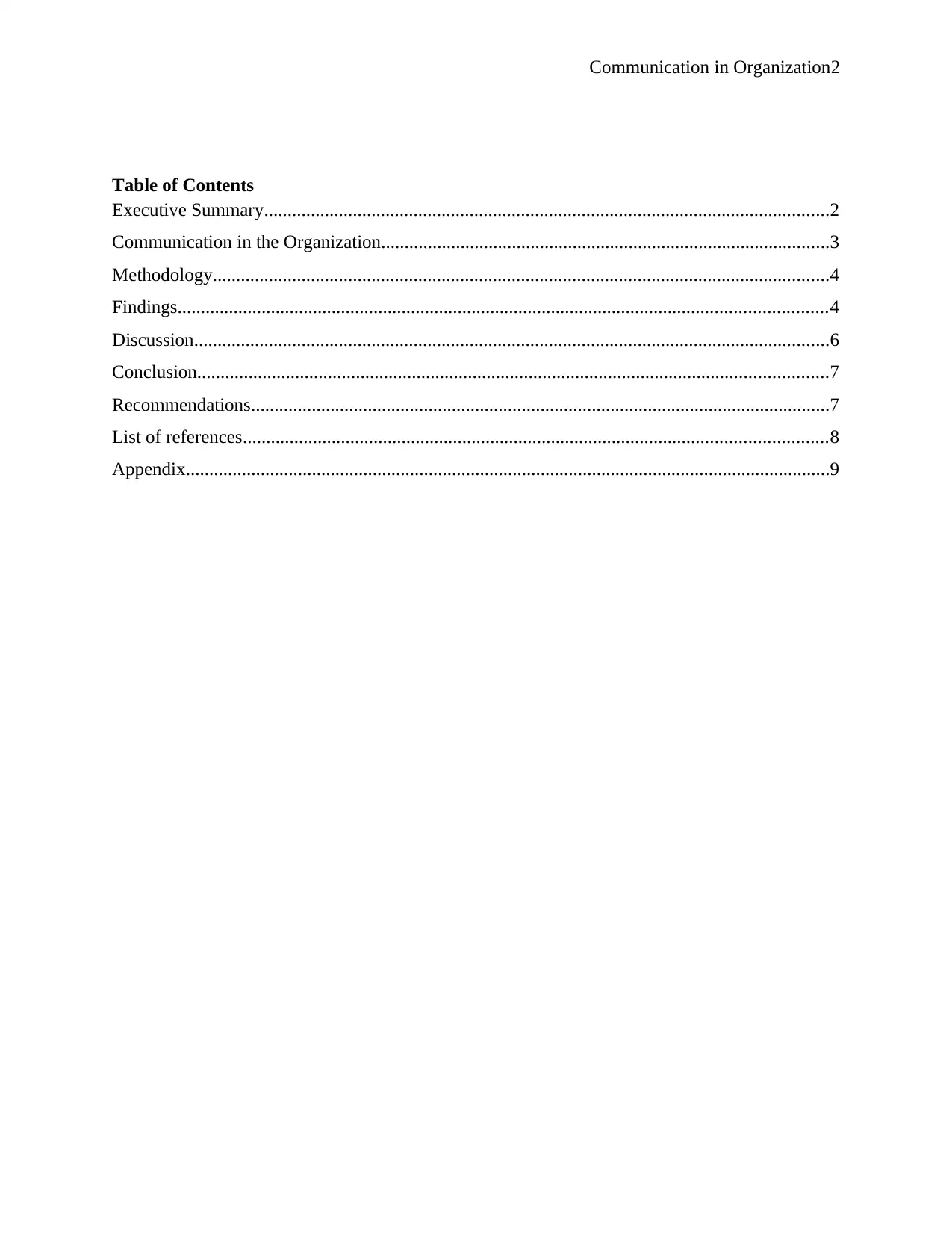
Communication in Organization2
Table of Contents
Executive Summary.........................................................................................................................2
Communication in the Organization................................................................................................3
Methodology....................................................................................................................................4
Findings...........................................................................................................................................4
Discussion........................................................................................................................................6
Conclusion.......................................................................................................................................7
Recommendations............................................................................................................................7
List of references.............................................................................................................................8
Appendix..........................................................................................................................................9
Table of Contents
Executive Summary.........................................................................................................................2
Communication in the Organization................................................................................................3
Methodology....................................................................................................................................4
Findings...........................................................................................................................................4
Discussion........................................................................................................................................6
Conclusion.......................................................................................................................................7
Recommendations............................................................................................................................7
List of references.............................................................................................................................8
Appendix..........................................................................................................................................9
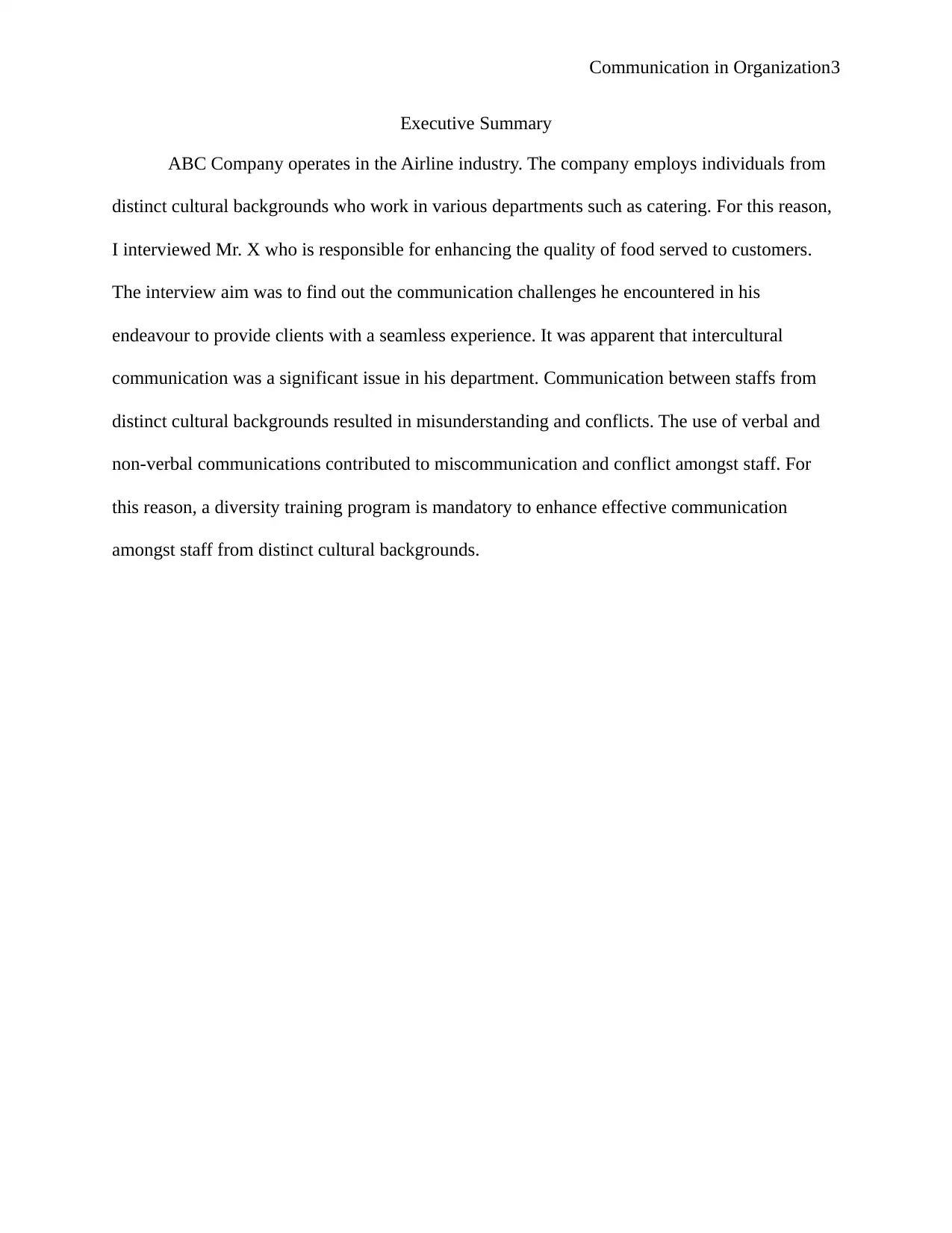
Communication in Organization3
Executive Summary
ABC Company operates in the Airline industry. The company employs individuals from
distinct cultural backgrounds who work in various departments such as catering. For this reason,
I interviewed Mr. X who is responsible for enhancing the quality of food served to customers.
The interview aim was to find out the communication challenges he encountered in his
endeavour to provide clients with a seamless experience. It was apparent that intercultural
communication was a significant issue in his department. Communication between staffs from
distinct cultural backgrounds resulted in misunderstanding and conflicts. The use of verbal and
non-verbal communications contributed to miscommunication and conflict amongst staff. For
this reason, a diversity training program is mandatory to enhance effective communication
amongst staff from distinct cultural backgrounds.
Executive Summary
ABC Company operates in the Airline industry. The company employs individuals from
distinct cultural backgrounds who work in various departments such as catering. For this reason,
I interviewed Mr. X who is responsible for enhancing the quality of food served to customers.
The interview aim was to find out the communication challenges he encountered in his
endeavour to provide clients with a seamless experience. It was apparent that intercultural
communication was a significant issue in his department. Communication between staffs from
distinct cultural backgrounds resulted in misunderstanding and conflicts. The use of verbal and
non-verbal communications contributed to miscommunication and conflict amongst staff. For
this reason, a diversity training program is mandatory to enhance effective communication
amongst staff from distinct cultural backgrounds.
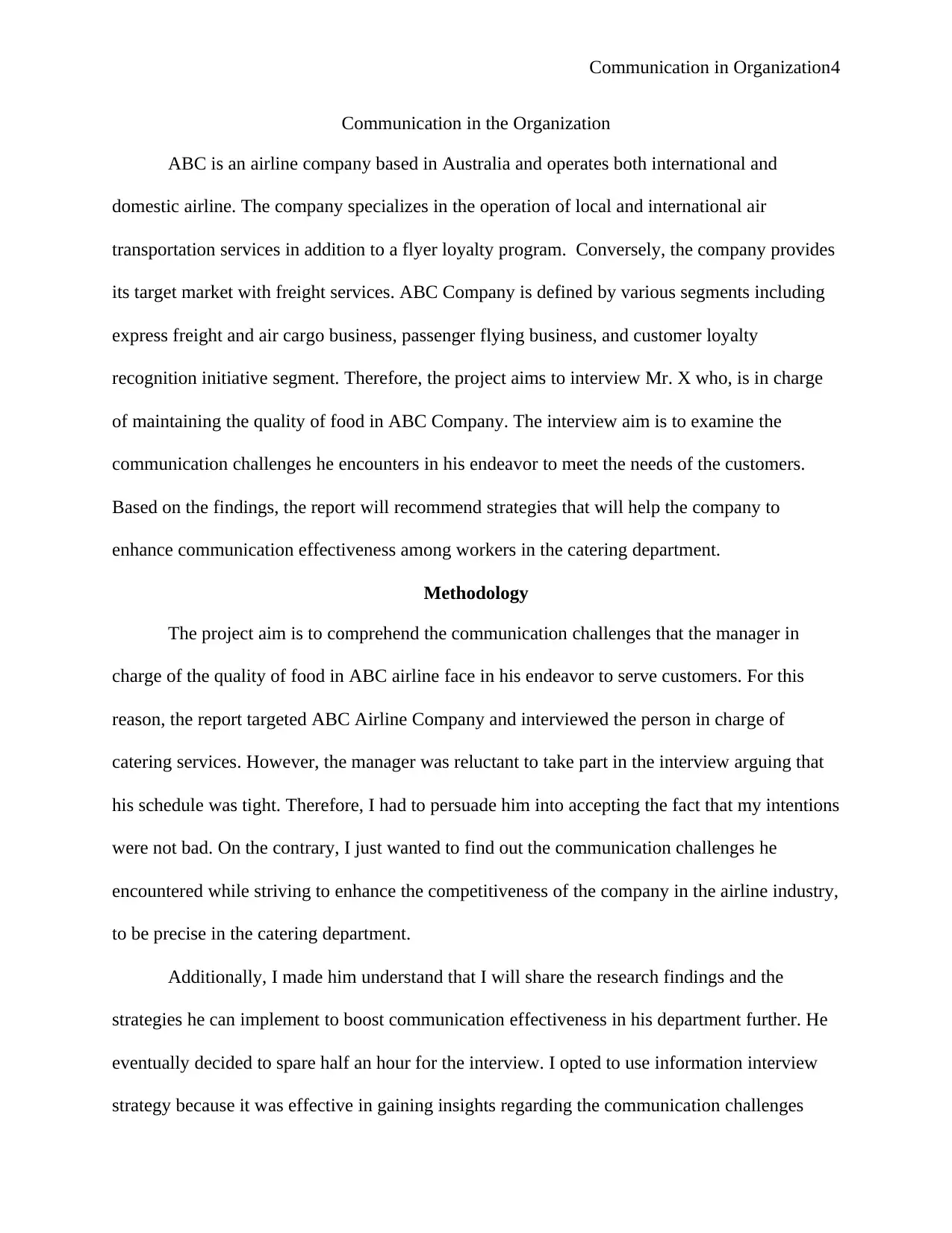
Communication in Organization4
Communication in the Organization
ABC is an airline company based in Australia and operates both international and
domestic airline. The company specializes in the operation of local and international air
transportation services in addition to a flyer loyalty program. Conversely, the company provides
its target market with freight services. ABC Company is defined by various segments including
express freight and air cargo business, passenger flying business, and customer loyalty
recognition initiative segment. Therefore, the project aims to interview Mr. X who, is in charge
of maintaining the quality of food in ABC Company. The interview aim is to examine the
communication challenges he encounters in his endeavor to meet the needs of the customers.
Based on the findings, the report will recommend strategies that will help the company to
enhance communication effectiveness among workers in the catering department.
Methodology
The project aim is to comprehend the communication challenges that the manager in
charge of the quality of food in ABC airline face in his endeavor to serve customers. For this
reason, the report targeted ABC Airline Company and interviewed the person in charge of
catering services. However, the manager was reluctant to take part in the interview arguing that
his schedule was tight. Therefore, I had to persuade him into accepting the fact that my intentions
were not bad. On the contrary, I just wanted to find out the communication challenges he
encountered while striving to enhance the competitiveness of the company in the airline industry,
to be precise in the catering department.
Additionally, I made him understand that I will share the research findings and the
strategies he can implement to boost communication effectiveness in his department further. He
eventually decided to spare half an hour for the interview. I opted to use information interview
strategy because it was effective in gaining insights regarding the communication challenges
Communication in the Organization
ABC is an airline company based in Australia and operates both international and
domestic airline. The company specializes in the operation of local and international air
transportation services in addition to a flyer loyalty program. Conversely, the company provides
its target market with freight services. ABC Company is defined by various segments including
express freight and air cargo business, passenger flying business, and customer loyalty
recognition initiative segment. Therefore, the project aims to interview Mr. X who, is in charge
of maintaining the quality of food in ABC Company. The interview aim is to examine the
communication challenges he encounters in his endeavor to meet the needs of the customers.
Based on the findings, the report will recommend strategies that will help the company to
enhance communication effectiveness among workers in the catering department.
Methodology
The project aim is to comprehend the communication challenges that the manager in
charge of the quality of food in ABC airline face in his endeavor to serve customers. For this
reason, the report targeted ABC Airline Company and interviewed the person in charge of
catering services. However, the manager was reluctant to take part in the interview arguing that
his schedule was tight. Therefore, I had to persuade him into accepting the fact that my intentions
were not bad. On the contrary, I just wanted to find out the communication challenges he
encountered while striving to enhance the competitiveness of the company in the airline industry,
to be precise in the catering department.
Additionally, I made him understand that I will share the research findings and the
strategies he can implement to boost communication effectiveness in his department further. He
eventually decided to spare half an hour for the interview. I opted to use information interview
strategy because it was effective in gaining insights regarding the communication challenges
Secure Best Marks with AI Grader
Need help grading? Try our AI Grader for instant feedback on your assignments.
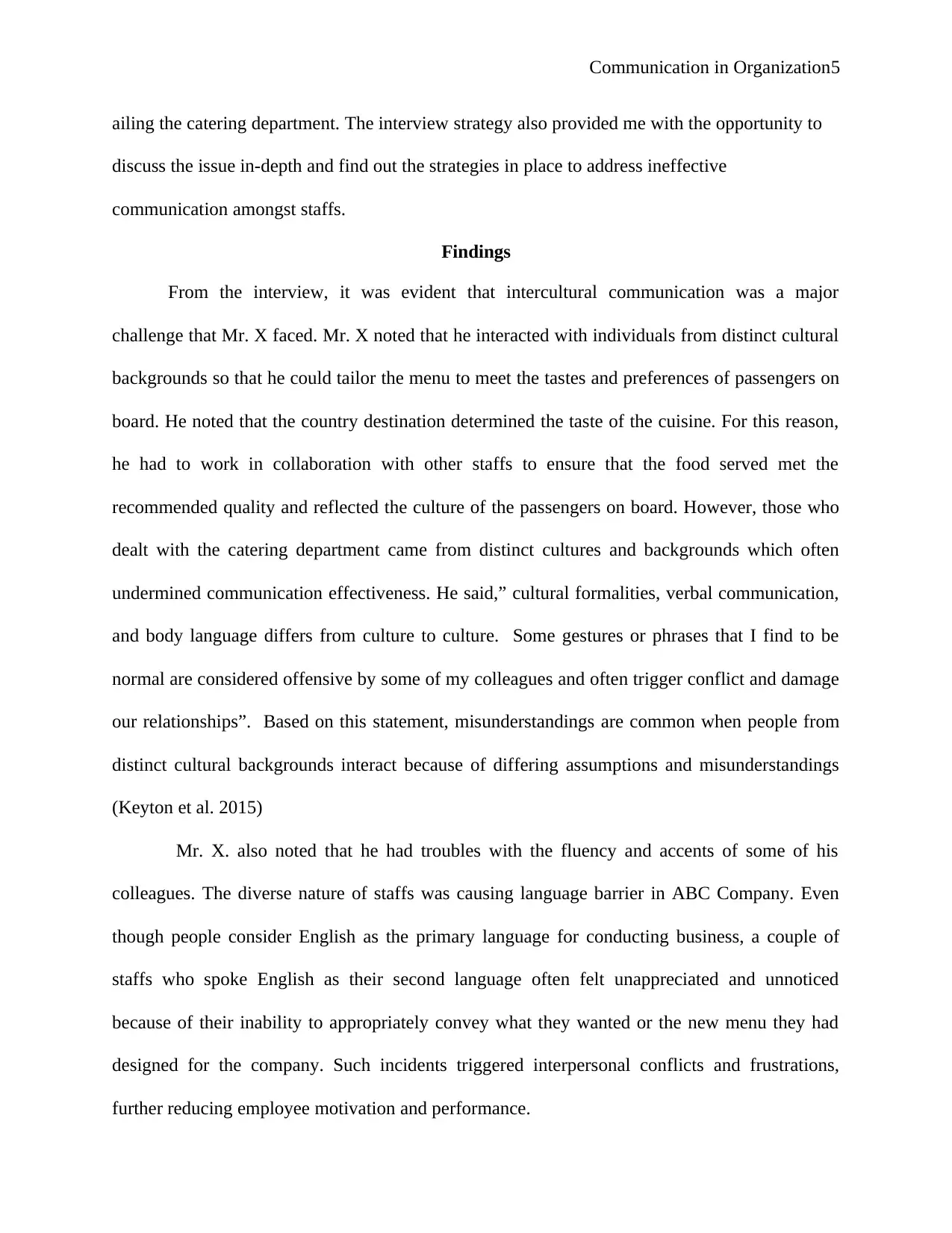
Communication in Organization5
ailing the catering department. The interview strategy also provided me with the opportunity to
discuss the issue in-depth and find out the strategies in place to address ineffective
communication amongst staffs.
Findings
From the interview, it was evident that intercultural communication was a major
challenge that Mr. X faced. Mr. X noted that he interacted with individuals from distinct cultural
backgrounds so that he could tailor the menu to meet the tastes and preferences of passengers on
board. He noted that the country destination determined the taste of the cuisine. For this reason,
he had to work in collaboration with other staffs to ensure that the food served met the
recommended quality and reflected the culture of the passengers on board. However, those who
dealt with the catering department came from distinct cultures and backgrounds which often
undermined communication effectiveness. He said,” cultural formalities, verbal communication,
and body language differs from culture to culture. Some gestures or phrases that I find to be
normal are considered offensive by some of my colleagues and often trigger conflict and damage
our relationships”. Based on this statement, misunderstandings are common when people from
distinct cultural backgrounds interact because of differing assumptions and misunderstandings
(Keyton et al. 2015)
Mr. X. also noted that he had troubles with the fluency and accents of some of his
colleagues. The diverse nature of staffs was causing language barrier in ABC Company. Even
though people consider English as the primary language for conducting business, a couple of
staffs who spoke English as their second language often felt unappreciated and unnoticed
because of their inability to appropriately convey what they wanted or the new menu they had
designed for the company. Such incidents triggered interpersonal conflicts and frustrations,
further reducing employee motivation and performance.
ailing the catering department. The interview strategy also provided me with the opportunity to
discuss the issue in-depth and find out the strategies in place to address ineffective
communication amongst staffs.
Findings
From the interview, it was evident that intercultural communication was a major
challenge that Mr. X faced. Mr. X noted that he interacted with individuals from distinct cultural
backgrounds so that he could tailor the menu to meet the tastes and preferences of passengers on
board. He noted that the country destination determined the taste of the cuisine. For this reason,
he had to work in collaboration with other staffs to ensure that the food served met the
recommended quality and reflected the culture of the passengers on board. However, those who
dealt with the catering department came from distinct cultures and backgrounds which often
undermined communication effectiveness. He said,” cultural formalities, verbal communication,
and body language differs from culture to culture. Some gestures or phrases that I find to be
normal are considered offensive by some of my colleagues and often trigger conflict and damage
our relationships”. Based on this statement, misunderstandings are common when people from
distinct cultural backgrounds interact because of differing assumptions and misunderstandings
(Keyton et al. 2015)
Mr. X. also noted that he had troubles with the fluency and accents of some of his
colleagues. The diverse nature of staffs was causing language barrier in ABC Company. Even
though people consider English as the primary language for conducting business, a couple of
staffs who spoke English as their second language often felt unappreciated and unnoticed
because of their inability to appropriately convey what they wanted or the new menu they had
designed for the company. Such incidents triggered interpersonal conflicts and frustrations,
further reducing employee motivation and performance.
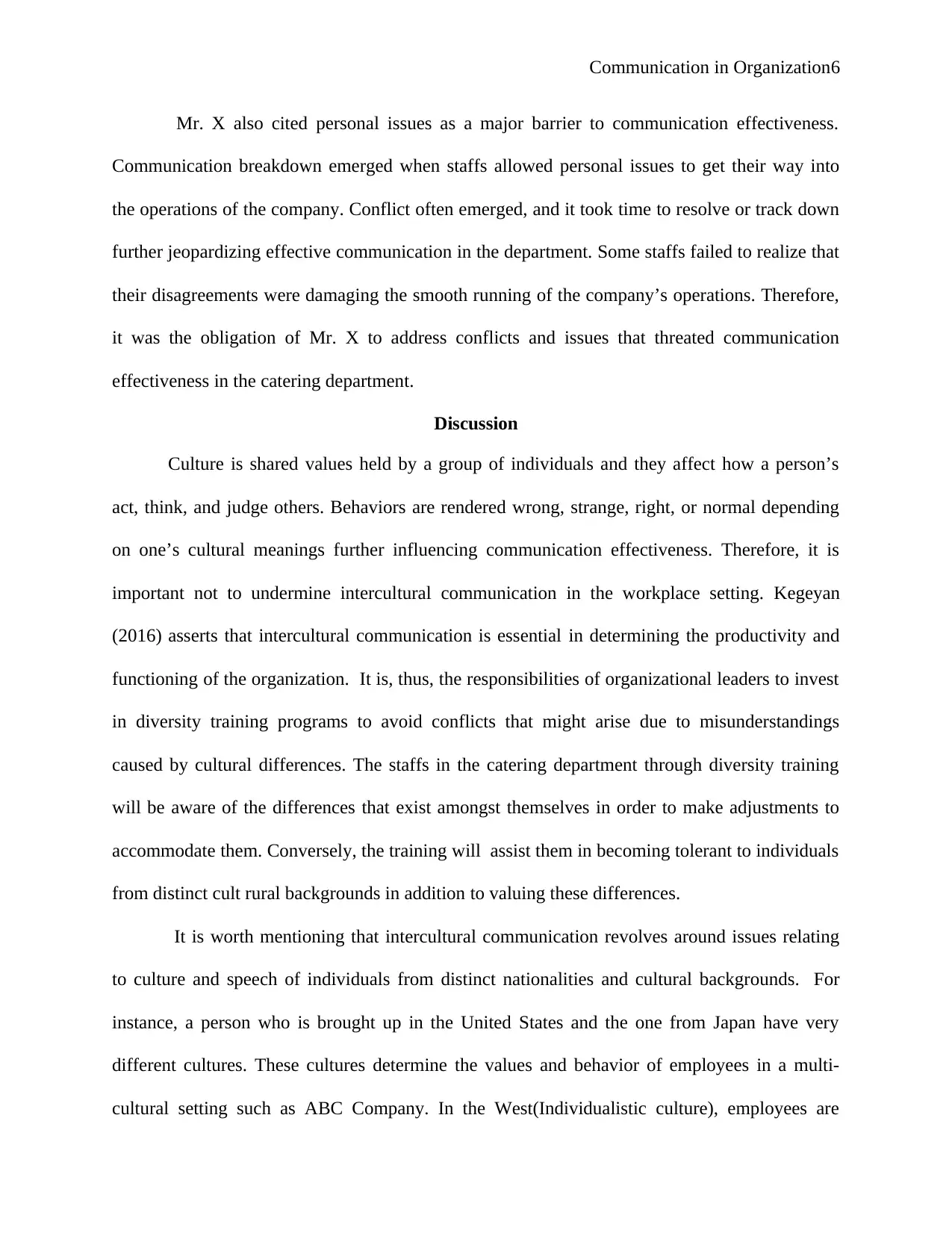
Communication in Organization6
Mr. X also cited personal issues as a major barrier to communication effectiveness.
Communication breakdown emerged when staffs allowed personal issues to get their way into
the operations of the company. Conflict often emerged, and it took time to resolve or track down
further jeopardizing effective communication in the department. Some staffs failed to realize that
their disagreements were damaging the smooth running of the company’s operations. Therefore,
it was the obligation of Mr. X to address conflicts and issues that threated communication
effectiveness in the catering department.
Discussion
Culture is shared values held by a group of individuals and they affect how a person’s
act, think, and judge others. Behaviors are rendered wrong, strange, right, or normal depending
on one’s cultural meanings further influencing communication effectiveness. Therefore, it is
important not to undermine intercultural communication in the workplace setting. Kegeyan
(2016) asserts that intercultural communication is essential in determining the productivity and
functioning of the organization. It is, thus, the responsibilities of organizational leaders to invest
in diversity training programs to avoid conflicts that might arise due to misunderstandings
caused by cultural differences. The staffs in the catering department through diversity training
will be aware of the differences that exist amongst themselves in order to make adjustments to
accommodate them. Conversely, the training will assist them in becoming tolerant to individuals
from distinct cult rural backgrounds in addition to valuing these differences.
It is worth mentioning that intercultural communication revolves around issues relating
to culture and speech of individuals from distinct nationalities and cultural backgrounds. For
instance, a person who is brought up in the United States and the one from Japan have very
different cultures. These cultures determine the values and behavior of employees in a multi-
cultural setting such as ABC Company. In the West(Individualistic culture), employees are
Mr. X also cited personal issues as a major barrier to communication effectiveness.
Communication breakdown emerged when staffs allowed personal issues to get their way into
the operations of the company. Conflict often emerged, and it took time to resolve or track down
further jeopardizing effective communication in the department. Some staffs failed to realize that
their disagreements were damaging the smooth running of the company’s operations. Therefore,
it was the obligation of Mr. X to address conflicts and issues that threated communication
effectiveness in the catering department.
Discussion
Culture is shared values held by a group of individuals and they affect how a person’s
act, think, and judge others. Behaviors are rendered wrong, strange, right, or normal depending
on one’s cultural meanings further influencing communication effectiveness. Therefore, it is
important not to undermine intercultural communication in the workplace setting. Kegeyan
(2016) asserts that intercultural communication is essential in determining the productivity and
functioning of the organization. It is, thus, the responsibilities of organizational leaders to invest
in diversity training programs to avoid conflicts that might arise due to misunderstandings
caused by cultural differences. The staffs in the catering department through diversity training
will be aware of the differences that exist amongst themselves in order to make adjustments to
accommodate them. Conversely, the training will assist them in becoming tolerant to individuals
from distinct cult rural backgrounds in addition to valuing these differences.
It is worth mentioning that intercultural communication revolves around issues relating
to culture and speech of individuals from distinct nationalities and cultural backgrounds. For
instance, a person who is brought up in the United States and the one from Japan have very
different cultures. These cultures determine the values and behavior of employees in a multi-
cultural setting such as ABC Company. In the West(Individualistic culture), employees are
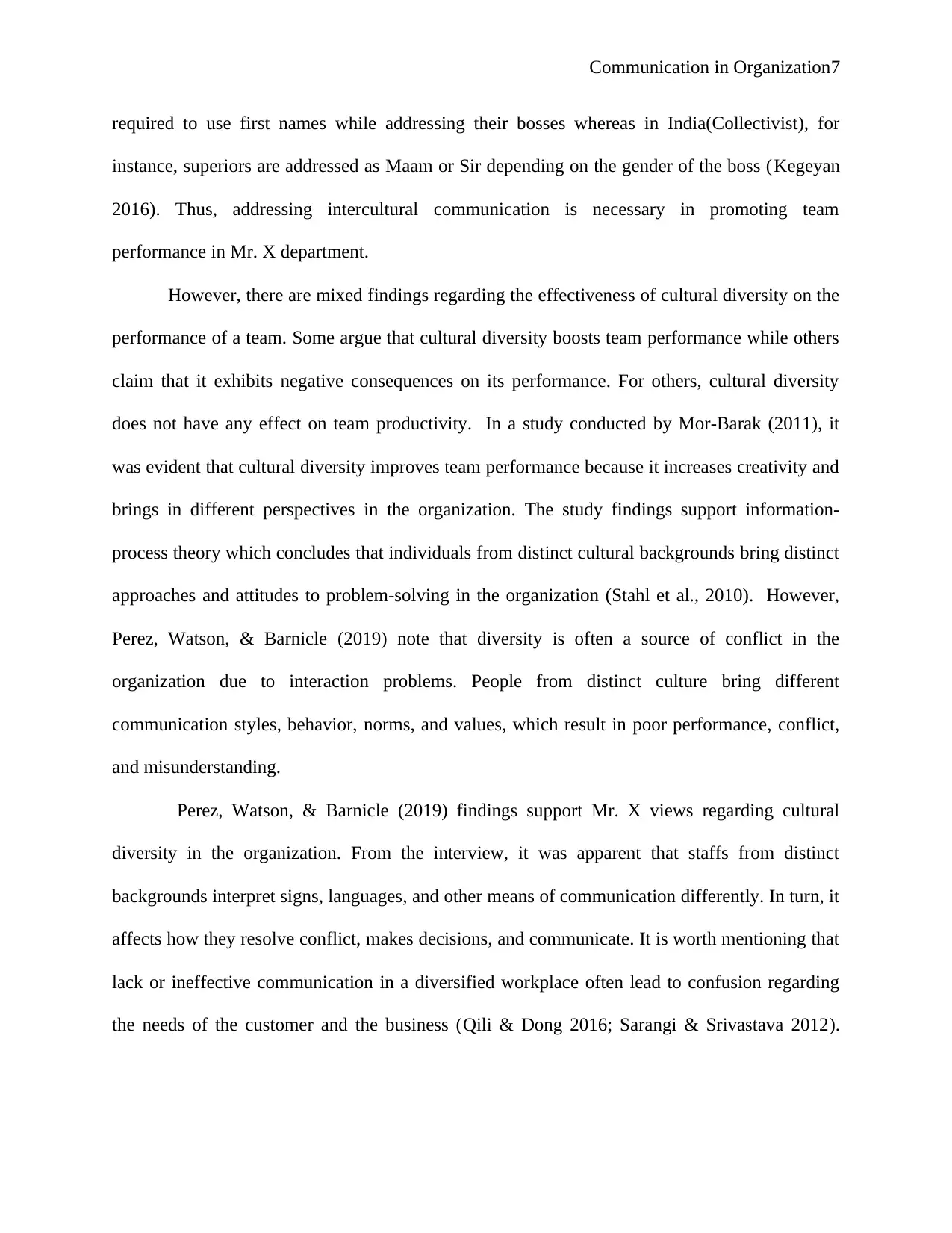
Communication in Organization7
required to use first names while addressing their bosses whereas in India(Collectivist), for
instance, superiors are addressed as Maam or Sir depending on the gender of the boss (Kegeyan
2016). Thus, addressing intercultural communication is necessary in promoting team
performance in Mr. X department.
However, there are mixed findings regarding the effectiveness of cultural diversity on the
performance of a team. Some argue that cultural diversity boosts team performance while others
claim that it exhibits negative consequences on its performance. For others, cultural diversity
does not have any effect on team productivity. In a study conducted by Mor-Barak (2011), it
was evident that cultural diversity improves team performance because it increases creativity and
brings in different perspectives in the organization. The study findings support information-
process theory which concludes that individuals from distinct cultural backgrounds bring distinct
approaches and attitudes to problem-solving in the organization (Stahl et al., 2010). However,
Perez, Watson, & Barnicle (2019) note that diversity is often a source of conflict in the
organization due to interaction problems. People from distinct culture bring different
communication styles, behavior, norms, and values, which result in poor performance, conflict,
and misunderstanding.
Perez, Watson, & Barnicle (2019) findings support Mr. X views regarding cultural
diversity in the organization. From the interview, it was apparent that staffs from distinct
backgrounds interpret signs, languages, and other means of communication differently. In turn, it
affects how they resolve conflict, makes decisions, and communicate. It is worth mentioning that
lack or ineffective communication in a diversified workplace often lead to confusion regarding
the needs of the customer and the business (Qili & Dong 2016; Sarangi & Srivastava 2012).
required to use first names while addressing their bosses whereas in India(Collectivist), for
instance, superiors are addressed as Maam or Sir depending on the gender of the boss (Kegeyan
2016). Thus, addressing intercultural communication is necessary in promoting team
performance in Mr. X department.
However, there are mixed findings regarding the effectiveness of cultural diversity on the
performance of a team. Some argue that cultural diversity boosts team performance while others
claim that it exhibits negative consequences on its performance. For others, cultural diversity
does not have any effect on team productivity. In a study conducted by Mor-Barak (2011), it
was evident that cultural diversity improves team performance because it increases creativity and
brings in different perspectives in the organization. The study findings support information-
process theory which concludes that individuals from distinct cultural backgrounds bring distinct
approaches and attitudes to problem-solving in the organization (Stahl et al., 2010). However,
Perez, Watson, & Barnicle (2019) note that diversity is often a source of conflict in the
organization due to interaction problems. People from distinct culture bring different
communication styles, behavior, norms, and values, which result in poor performance, conflict,
and misunderstanding.
Perez, Watson, & Barnicle (2019) findings support Mr. X views regarding cultural
diversity in the organization. From the interview, it was apparent that staffs from distinct
backgrounds interpret signs, languages, and other means of communication differently. In turn, it
affects how they resolve conflict, makes decisions, and communicate. It is worth mentioning that
lack or ineffective communication in a diversified workplace often lead to confusion regarding
the needs of the customer and the business (Qili & Dong 2016; Sarangi & Srivastava 2012).
Paraphrase This Document
Need a fresh take? Get an instant paraphrase of this document with our AI Paraphraser
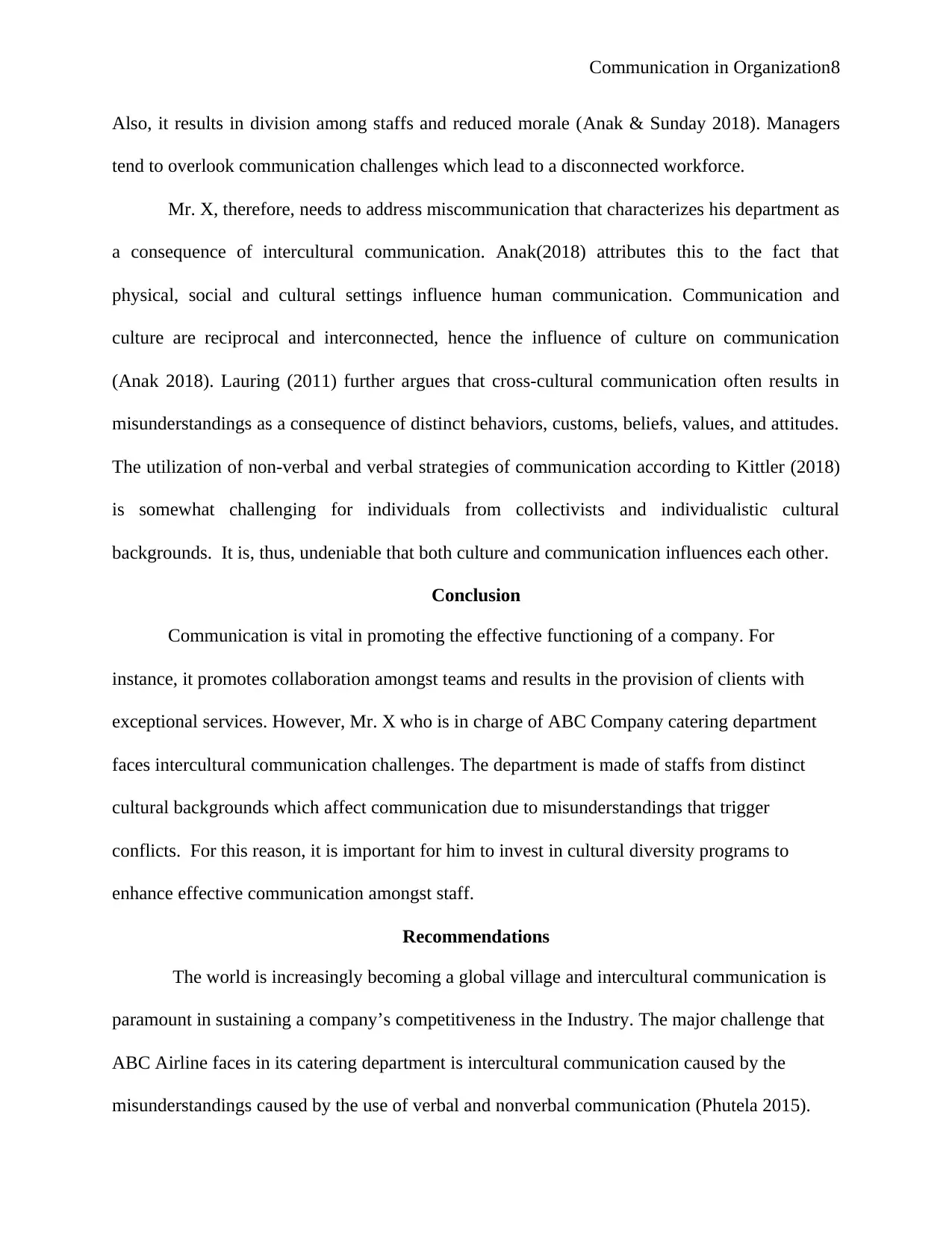
Communication in Organization8
Also, it results in division among staffs and reduced morale (Anak & Sunday 2018). Managers
tend to overlook communication challenges which lead to a disconnected workforce.
Mr. X, therefore, needs to address miscommunication that characterizes his department as
a consequence of intercultural communication. Anak(2018) attributes this to the fact that
physical, social and cultural settings influence human communication. Communication and
culture are reciprocal and interconnected, hence the influence of culture on communication
(Anak 2018). Lauring (2011) further argues that cross-cultural communication often results in
misunderstandings as a consequence of distinct behaviors, customs, beliefs, values, and attitudes.
The utilization of non-verbal and verbal strategies of communication according to Kittler (2018)
is somewhat challenging for individuals from collectivists and individualistic cultural
backgrounds. It is, thus, undeniable that both culture and communication influences each other.
Conclusion
Communication is vital in promoting the effective functioning of a company. For
instance, it promotes collaboration amongst teams and results in the provision of clients with
exceptional services. However, Mr. X who is in charge of ABC Company catering department
faces intercultural communication challenges. The department is made of staffs from distinct
cultural backgrounds which affect communication due to misunderstandings that trigger
conflicts. For this reason, it is important for him to invest in cultural diversity programs to
enhance effective communication amongst staff.
Recommendations
The world is increasingly becoming a global village and intercultural communication is
paramount in sustaining a company’s competitiveness in the Industry. The major challenge that
ABC Airline faces in its catering department is intercultural communication caused by the
misunderstandings caused by the use of verbal and nonverbal communication (Phutela 2015).
Also, it results in division among staffs and reduced morale (Anak & Sunday 2018). Managers
tend to overlook communication challenges which lead to a disconnected workforce.
Mr. X, therefore, needs to address miscommunication that characterizes his department as
a consequence of intercultural communication. Anak(2018) attributes this to the fact that
physical, social and cultural settings influence human communication. Communication and
culture are reciprocal and interconnected, hence the influence of culture on communication
(Anak 2018). Lauring (2011) further argues that cross-cultural communication often results in
misunderstandings as a consequence of distinct behaviors, customs, beliefs, values, and attitudes.
The utilization of non-verbal and verbal strategies of communication according to Kittler (2018)
is somewhat challenging for individuals from collectivists and individualistic cultural
backgrounds. It is, thus, undeniable that both culture and communication influences each other.
Conclusion
Communication is vital in promoting the effective functioning of a company. For
instance, it promotes collaboration amongst teams and results in the provision of clients with
exceptional services. However, Mr. X who is in charge of ABC Company catering department
faces intercultural communication challenges. The department is made of staffs from distinct
cultural backgrounds which affect communication due to misunderstandings that trigger
conflicts. For this reason, it is important for him to invest in cultural diversity programs to
enhance effective communication amongst staff.
Recommendations
The world is increasingly becoming a global village and intercultural communication is
paramount in sustaining a company’s competitiveness in the Industry. The major challenge that
ABC Airline faces in its catering department is intercultural communication caused by the
misunderstandings caused by the use of verbal and nonverbal communication (Phutela 2015).
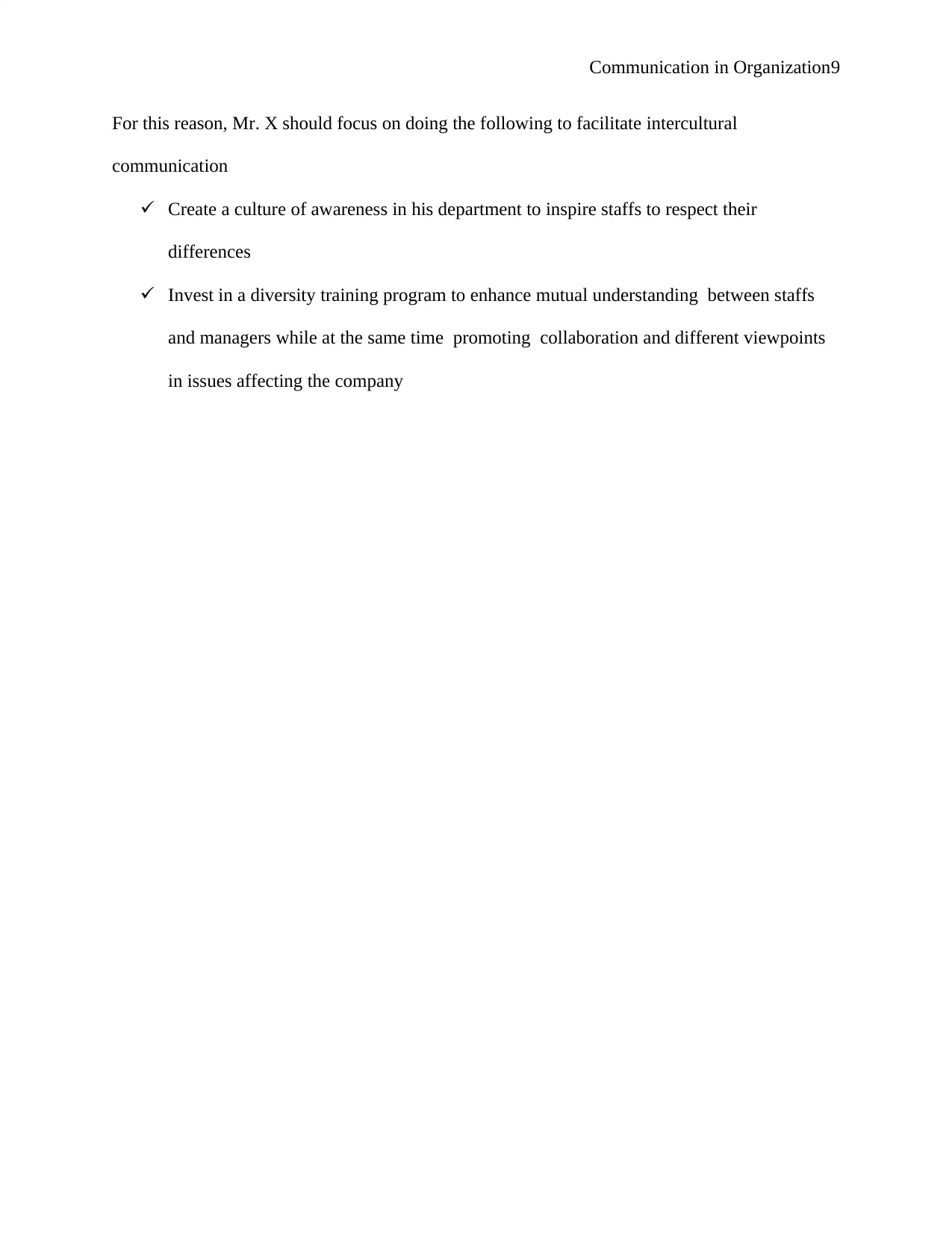
Communication in Organization9
For this reason, Mr. X should focus on doing the following to facilitate intercultural
communication
Create a culture of awareness in his department to inspire staffs to respect their
differences
Invest in a diversity training program to enhance mutual understanding between staffs
and managers while at the same time promoting collaboration and different viewpoints
in issues affecting the company
For this reason, Mr. X should focus on doing the following to facilitate intercultural
communication
Create a culture of awareness in his department to inspire staffs to respect their
differences
Invest in a diversity training program to enhance mutual understanding between staffs
and managers while at the same time promoting collaboration and different viewpoints
in issues affecting the company
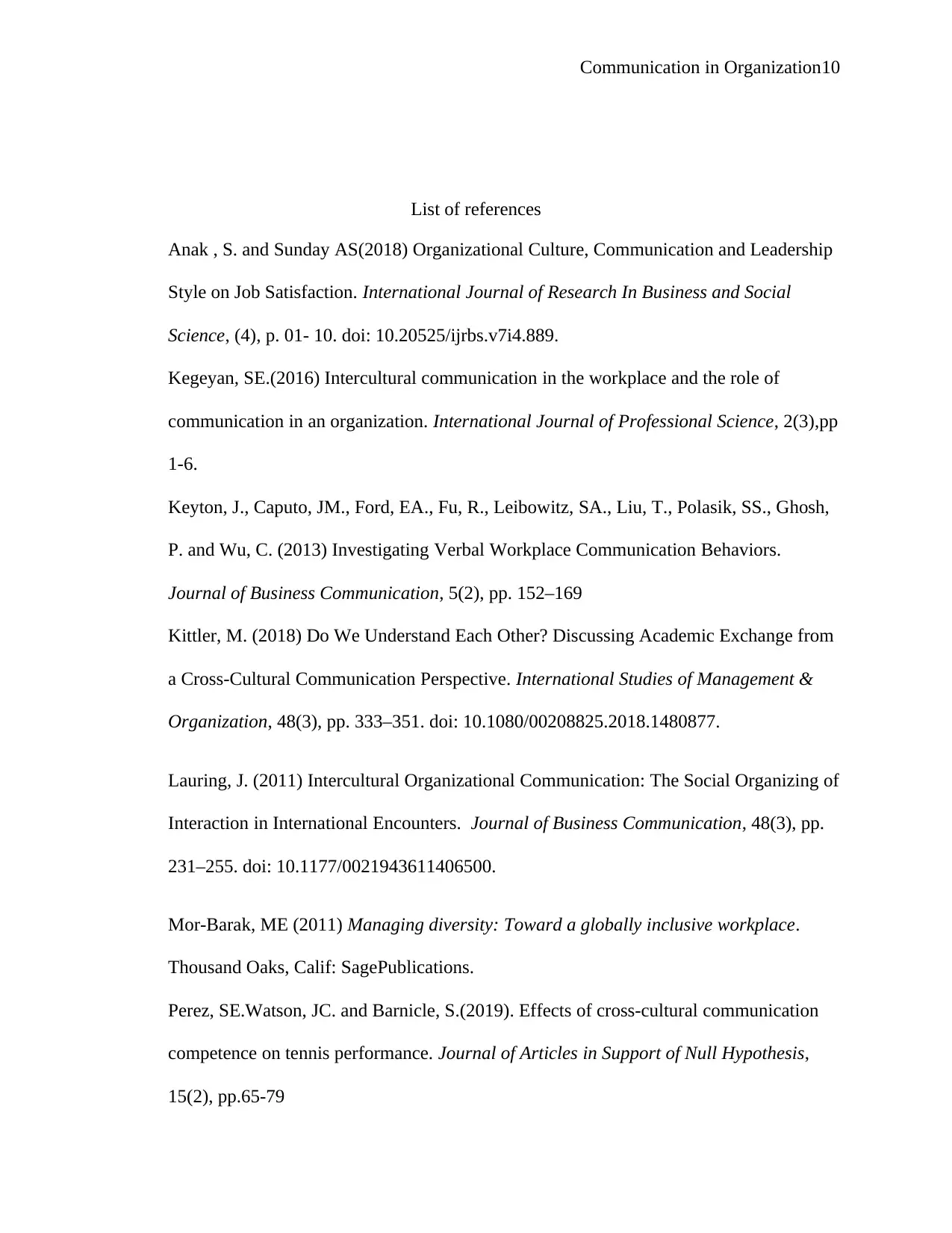
Communication in Organization10
List of references
Anak , S. and Sunday AS(2018) Organizational Culture, Communication and Leadership
Style on Job Satisfaction. International Journal of Research In Business and Social
Science, (4), p. 01- 10. doi: 10.20525/ijrbs.v7i4.889.
Kegeyan, SE.(2016) Intercultural communication in the workplace and the role of
communication in an organization. International Journal of Professional Science, 2(3),pp
1-6.
Keyton, J., Caputo, JM., Ford, EA., Fu, R., Leibowitz, SA., Liu, T., Polasik, SS., Ghosh,
P. and Wu, C. (2013) Investigating Verbal Workplace Communication Behaviors.
Journal of Business Communication, 5(2), pp. 152–169
Kittler, M. (2018) Do We Understand Each Other? Discussing Academic Exchange from
a Cross-Cultural Communication Perspective. International Studies of Management &
Organization, 48(3), pp. 333–351. doi: 10.1080/00208825.2018.1480877.
Lauring, J. (2011) Intercultural Organizational Communication: The Social Organizing of
Interaction in International Encounters. Journal of Business Communication, 48(3), pp.
231–255. doi: 10.1177/0021943611406500.
Mor-Barak, ME (2011) Managing diversity: Toward a globally inclusive workplace.
Thousand Oaks, Calif: SagePublications.
Perez, SE.Watson, JC. and Barnicle, S.(2019). Effects of cross-cultural communication
competence on tennis performance. Journal of Articles in Support of Null Hypothesis,
15(2), pp.65-79
List of references
Anak , S. and Sunday AS(2018) Organizational Culture, Communication and Leadership
Style on Job Satisfaction. International Journal of Research In Business and Social
Science, (4), p. 01- 10. doi: 10.20525/ijrbs.v7i4.889.
Kegeyan, SE.(2016) Intercultural communication in the workplace and the role of
communication in an organization. International Journal of Professional Science, 2(3),pp
1-6.
Keyton, J., Caputo, JM., Ford, EA., Fu, R., Leibowitz, SA., Liu, T., Polasik, SS., Ghosh,
P. and Wu, C. (2013) Investigating Verbal Workplace Communication Behaviors.
Journal of Business Communication, 5(2), pp. 152–169
Kittler, M. (2018) Do We Understand Each Other? Discussing Academic Exchange from
a Cross-Cultural Communication Perspective. International Studies of Management &
Organization, 48(3), pp. 333–351. doi: 10.1080/00208825.2018.1480877.
Lauring, J. (2011) Intercultural Organizational Communication: The Social Organizing of
Interaction in International Encounters. Journal of Business Communication, 48(3), pp.
231–255. doi: 10.1177/0021943611406500.
Mor-Barak, ME (2011) Managing diversity: Toward a globally inclusive workplace.
Thousand Oaks, Calif: SagePublications.
Perez, SE.Watson, JC. and Barnicle, S.(2019). Effects of cross-cultural communication
competence on tennis performance. Journal of Articles in Support of Null Hypothesis,
15(2), pp.65-79
Secure Best Marks with AI Grader
Need help grading? Try our AI Grader for instant feedback on your assignments.
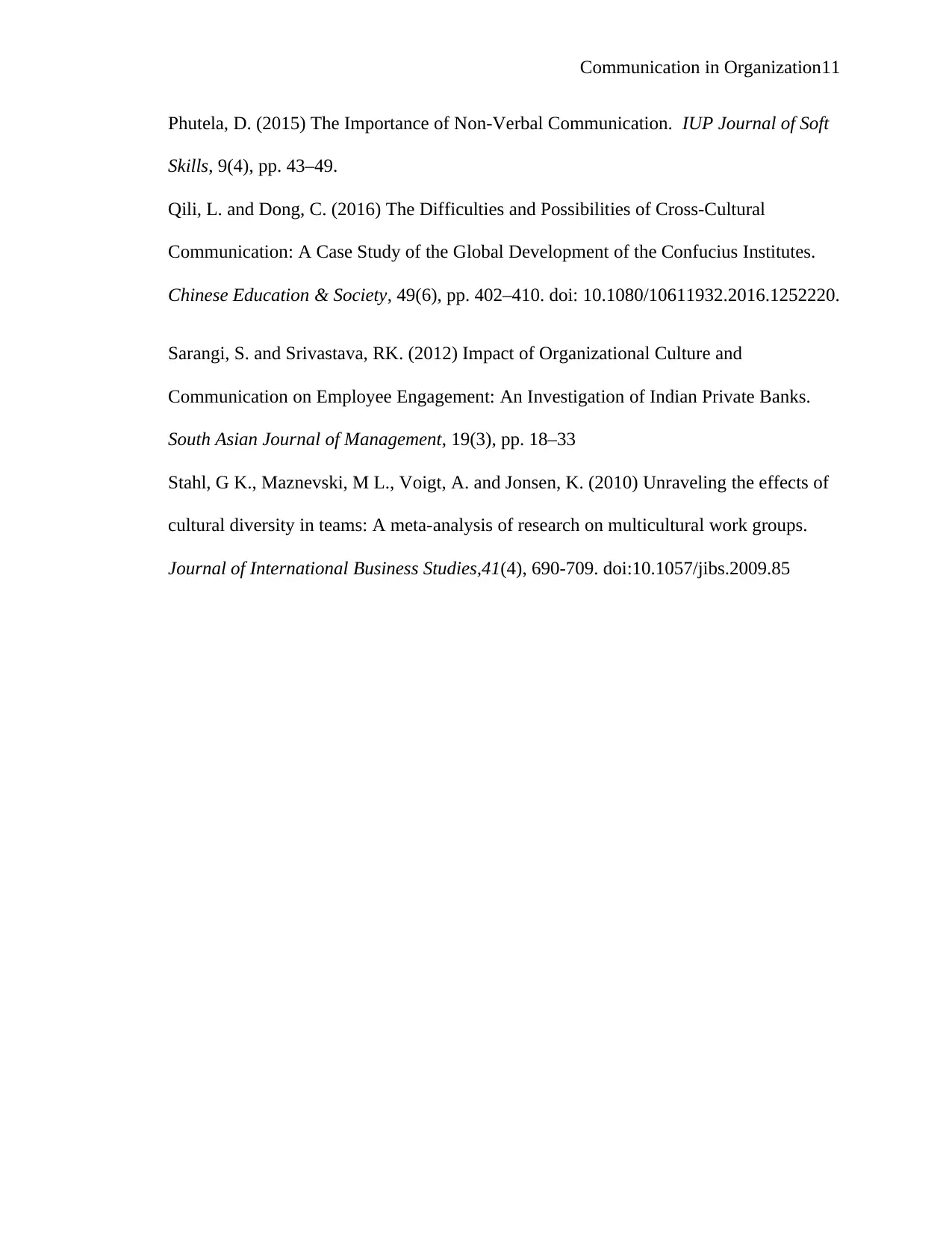
Communication in Organization11
Phutela, D. (2015) The Importance of Non-Verbal Communication. IUP Journal of Soft
Skills, 9(4), pp. 43–49.
Qili, L. and Dong, C. (2016) The Difficulties and Possibilities of Cross-Cultural
Communication: A Case Study of the Global Development of the Confucius Institutes.
Chinese Education & Society, 49(6), pp. 402–410. doi: 10.1080/10611932.2016.1252220.
Sarangi, S. and Srivastava, RK. (2012) Impact of Organizational Culture and
Communication on Employee Engagement: An Investigation of Indian Private Banks.
South Asian Journal of Management, 19(3), pp. 18–33
Stahl, G K., Maznevski, M L., Voigt, A. and Jonsen, K. (2010) Unraveling the effects of
cultural diversity in teams: A meta-analysis of research on multicultural work groups.
Journal of International Business Studies,41(4), 690-709. doi:10.1057/jibs.2009.85
Phutela, D. (2015) The Importance of Non-Verbal Communication. IUP Journal of Soft
Skills, 9(4), pp. 43–49.
Qili, L. and Dong, C. (2016) The Difficulties and Possibilities of Cross-Cultural
Communication: A Case Study of the Global Development of the Confucius Institutes.
Chinese Education & Society, 49(6), pp. 402–410. doi: 10.1080/10611932.2016.1252220.
Sarangi, S. and Srivastava, RK. (2012) Impact of Organizational Culture and
Communication on Employee Engagement: An Investigation of Indian Private Banks.
South Asian Journal of Management, 19(3), pp. 18–33
Stahl, G K., Maznevski, M L., Voigt, A. and Jonsen, K. (2010) Unraveling the effects of
cultural diversity in teams: A meta-analysis of research on multicultural work groups.
Journal of International Business Studies,41(4), 690-709. doi:10.1057/jibs.2009.85
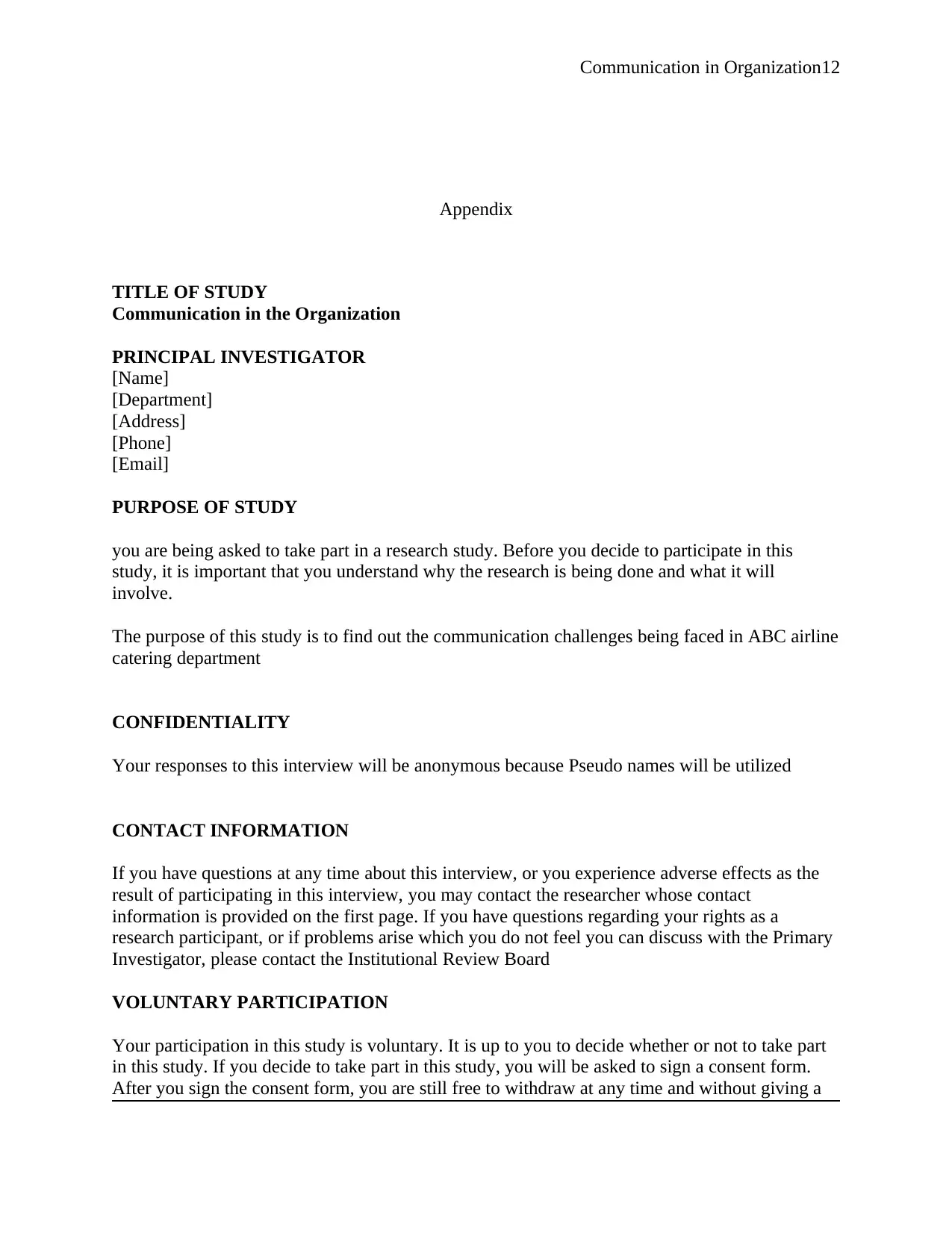
Communication in Organization12
Appendix
TITLE OF STUDY
Communication in the Organization
PRINCIPAL INVESTIGATOR
[Name]
[Department]
[Address]
[Phone]
[Email]
PURPOSE OF STUDY
you are being asked to take part in a research study. Before you decide to participate in this
study, it is important that you understand why the research is being done and what it will
involve.
The purpose of this study is to find out the communication challenges being faced in ABC airline
catering department
CONFIDENTIALITY
Your responses to this interview will be anonymous because Pseudo names will be utilized
CONTACT INFORMATION
If you have questions at any time about this interview, or you experience adverse effects as the
result of participating in this interview, you may contact the researcher whose contact
information is provided on the first page. If you have questions regarding your rights as a
research participant, or if problems arise which you do not feel you can discuss with the Primary
Investigator, please contact the Institutional Review Board
VOLUNTARY PARTICIPATION
Your participation in this study is voluntary. It is up to you to decide whether or not to take part
in this study. If you decide to take part in this study, you will be asked to sign a consent form.
After you sign the consent form, you are still free to withdraw at any time and without giving a
Appendix
TITLE OF STUDY
Communication in the Organization
PRINCIPAL INVESTIGATOR
[Name]
[Department]
[Address]
[Phone]
[Email]
PURPOSE OF STUDY
you are being asked to take part in a research study. Before you decide to participate in this
study, it is important that you understand why the research is being done and what it will
involve.
The purpose of this study is to find out the communication challenges being faced in ABC airline
catering department
CONFIDENTIALITY
Your responses to this interview will be anonymous because Pseudo names will be utilized
CONTACT INFORMATION
If you have questions at any time about this interview, or you experience adverse effects as the
result of participating in this interview, you may contact the researcher whose contact
information is provided on the first page. If you have questions regarding your rights as a
research participant, or if problems arise which you do not feel you can discuss with the Primary
Investigator, please contact the Institutional Review Board
VOLUNTARY PARTICIPATION
Your participation in this study is voluntary. It is up to you to decide whether or not to take part
in this study. If you decide to take part in this study, you will be asked to sign a consent form.
After you sign the consent form, you are still free to withdraw at any time and without giving a
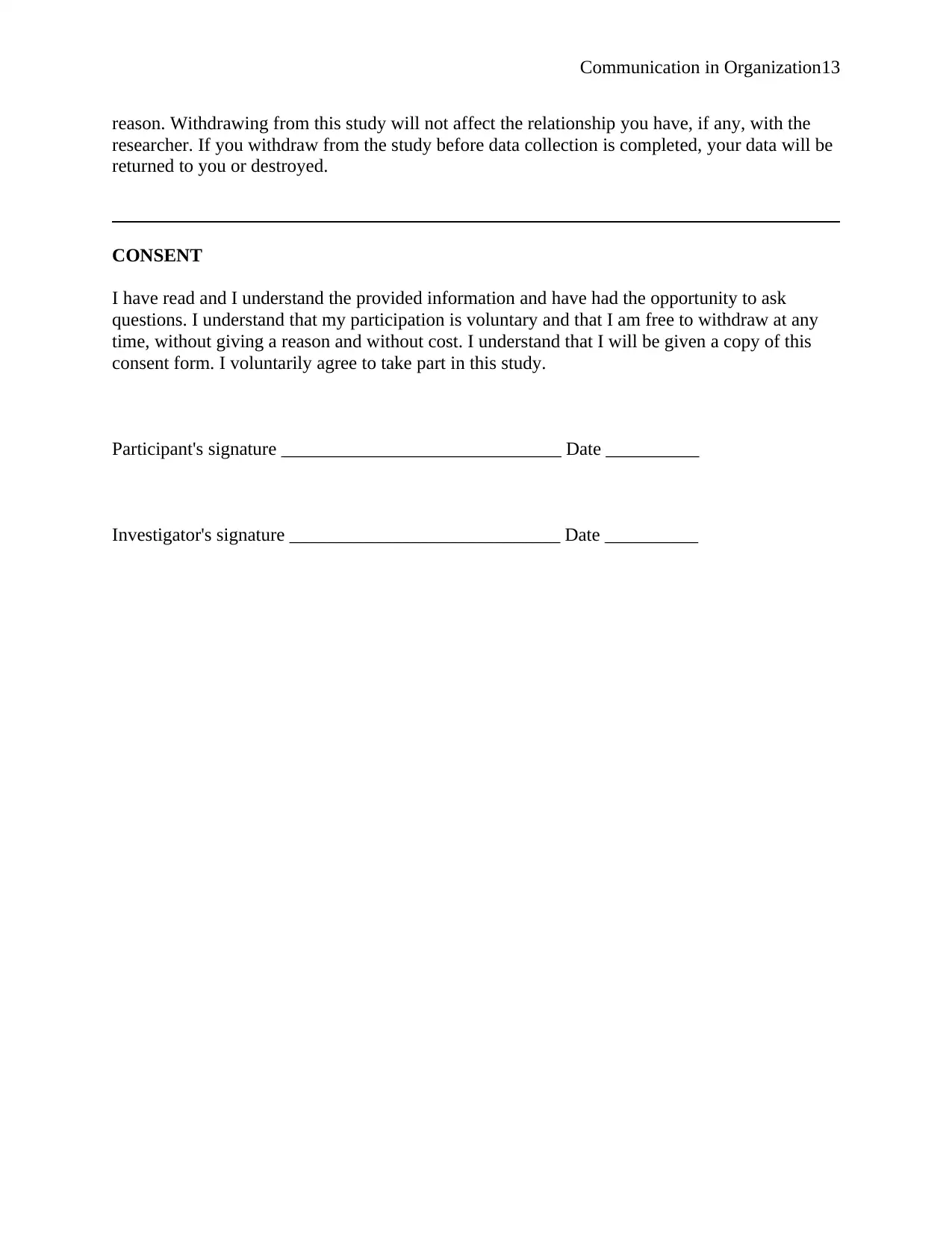
Communication in Organization13
reason. Withdrawing from this study will not affect the relationship you have, if any, with the
researcher. If you withdraw from the study before data collection is completed, your data will be
returned to you or destroyed.
CONSENT
I have read and I understand the provided information and have had the opportunity to ask
questions. I understand that my participation is voluntary and that I am free to withdraw at any
time, without giving a reason and without cost. I understand that I will be given a copy of this
consent form. I voluntarily agree to take part in this study.
Participant's signature ______________________________ Date __________
Investigator's signature _____________________________ Date __________
reason. Withdrawing from this study will not affect the relationship you have, if any, with the
researcher. If you withdraw from the study before data collection is completed, your data will be
returned to you or destroyed.
CONSENT
I have read and I understand the provided information and have had the opportunity to ask
questions. I understand that my participation is voluntary and that I am free to withdraw at any
time, without giving a reason and without cost. I understand that I will be given a copy of this
consent form. I voluntarily agree to take part in this study.
Participant's signature ______________________________ Date __________
Investigator's signature _____________________________ Date __________
1 out of 13
Your All-in-One AI-Powered Toolkit for Academic Success.
+13062052269
info@desklib.com
Available 24*7 on WhatsApp / Email
![[object Object]](/_next/static/media/star-bottom.7253800d.svg)
Unlock your academic potential
© 2024 | Zucol Services PVT LTD | All rights reserved.
